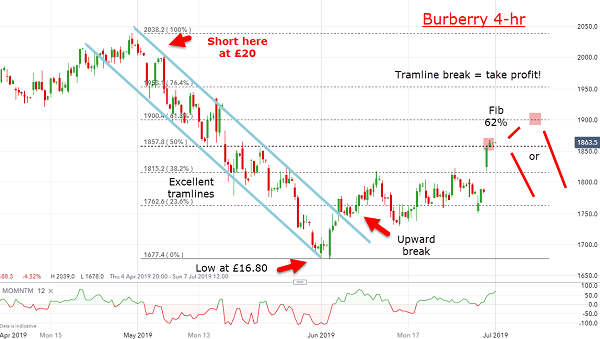Chart of the week: A strategy built for quick profits
This trading strategy is ideal for investors who find it easy to buy shares but struggle to sell them.
1st July 2019 15:35
by John Burford from interactive investor
This trading strategy is ideal for investors who find it easy to buy shares but struggle to sell them.

Burberry turns at my target
This week I thought I would explain how I handle swing trades – taking smaller short-term gains and cutting losses quickly - using my Tramline methods so as to extract as much profit from them as possible (without possessing a crystal ball). Those with superior psychic abilities can skip this piece.
I know many traders/investors feel they are abandoned and alone in a trade without a sure set of guidelines of how, when or where to exit it. Hopefully, this will help.
It is often said that getting in to a trade is the easy part of trading, deciding when to exit is a whole lot more difficult. Most pundits generally avoid the subject altogether. But my Tramline methods offer solid guidelines to help in this crucial aspect.
This is how I used my methods to handle my recent short position in Burberry (LSE:BRBY) as outlined in my COTW of April 23.
This is what I wrote then:
"But the Fibonacci 62% retrace lies directly ahead in the £20.60 region and that is the normal area for a reversal. My best guess is for a major turn lower from around that area or before (currently £20.10)."
As it happened, the shares made its turn a few days later at the £20.40 high and started heading lower, as forecast. And as the shares declined, I was able to draw a nice trading channel between a pair of tramlines. This is what I had:

Source: interactive investor Past performance is not a guide to future performance
From the high, the market traced out waves down between my new tramlines. Remember, tramlines are straight lines of support (lower) and resistance (upper).
All was well until the market broke out of the channel on 5 June, marking a significant change of trend.
That was my signal to exit my trade at £17.50 for a tidy profit of £2.50 (12.5%) - magnified by any leveraged used. And since then, the shares have advanced to the Fibonacci 62% retrace of the decline from late-April high to early-June low.
And this morning, it has hit my target around the £19 area – the moment of truth!
For more information about Tramline Traders, or to take a three-week free trial, go to www.tramlinetraders.com.
John Burford is the author of the definitive text on his trading method, Tramline Trading. He is also a freelance contributor and not a direct employee of interactive investor.
These articles are provided for information purposes only. Occasionally, an opinion about whether to buy or sell a specific investment may be provided by third parties. The content is not intended to be a personal recommendation to buy or sell any financial instrument or product, or to adopt any investment strategy as it is not provided based on an assessment of your investing knowledge and experience, your financial situation or your investment objectives. The value of your investments, and the income derived from them, may go down as well as up. You may not get back all the money that you invest. The investments referred to in this article may not be suitable for all investors, and if in doubt, an investor should seek advice from a qualified investment adviser.
Full performance can be found on the company or index summary page on the interactive investor website. Simply click on the company's or index name highlighted in the article.
Disclosure
We use a combination of fundamental and technical analysis in forming our view as to the valuation and prospects of an investment. Where relevant we have set out those particular matters we think are important in the above article, but further detail can be found here.
Please note that our article on this investment should not be considered to be a regular publication.
Details of all recommendations issued by ii during the previous 12-month period can be found here.
ii adheres to a strict code of conduct. Contributors may hold shares or have other interests in companies included in these portfolios, which could create a conflict of interests. Contributors intending to write about any financial instruments in which they have an interest are required to disclose such interest to ii and in the article itself. ii will at all times consider whether such interest impairs the objectivity of the recommendation.
In addition, individuals involved in the production of investment articles are subject to a personal account dealing restriction, which prevents them from placing a transaction in the specified instrument(s) for a period before and for five working days after such publication. This is to avoid personal interests conflicting with the interests of the recipients of those investment articles.